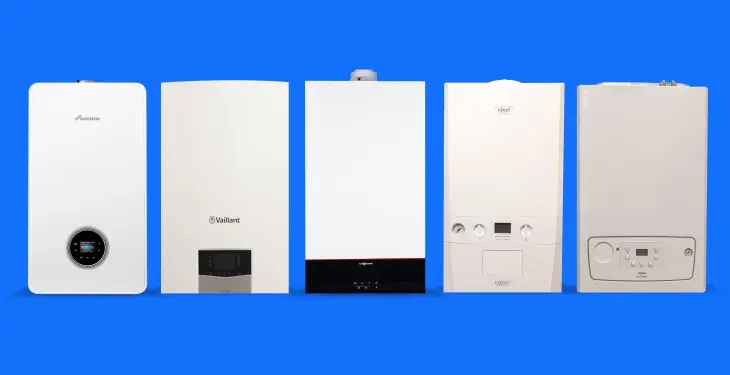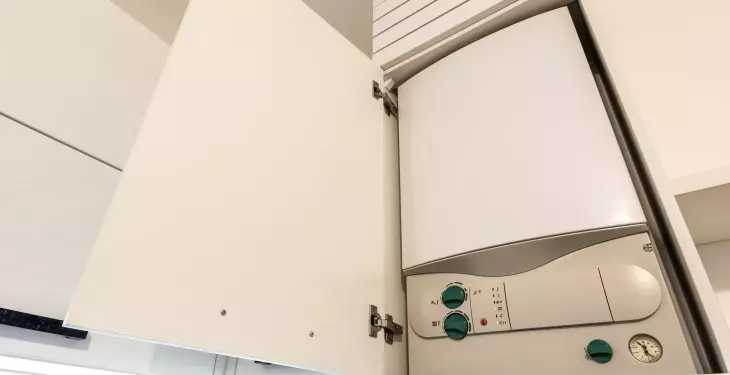

Written by Stephen Day
Gas Safe Engineer
Updated: 30th May, 2025
When an Ideal boiler displays the L-F fault code, it is indicative of a flame loss issue. This problem can arise due to various reasons, from simple to complex, affecting the boiler's ability to operate.
Get a new boiler quote, save up to £550 per year (0% APR available).
Encountering the L-F error code on an Ideal boiler is a signal that the unit is experiencing ignition failure. This issue arises when the boiler attempts to ignite multiple times without success, prompting the system to lock out as a safety measure.
It is a common fault code that often indicates an inability of the boiler to detect a flame, despite the gas valve opening. Homeowners may notice that their boiler stops working and displays the L-F error on the control panel, alerting them to the ignition problem.
Get a quote in 60 seconds, fitted as fast as next day!
0% APR finance available.
Troubleshooting steps for an L-F error can range from simple checks, such as ensuring there is no interruption in the gas supply, to more complex diagnostics, like inspecting the condition of the ignition leads or the flame sensor.
The role of these components is central to a successful ignition sequence, and any faults can lead to the recurrent error code. Professional assistance is usually required to accurately diagnose and resolve underlying issues that cause an L-F error code, especially because handling gas appliances can be dangerous and should only be undertaken by a qualified engineer.
When an Ideal boiler displays the L-F fault code, it is indicative of a flame loss issue. This problem can arise due to various reasons, from simple to complex, affecting the boiler's ability to operate. The boiler's control system has detected that the flame, which is necessary for heating, has been extinguished unexpectedly.
Typically, the emergence of the L-F error is tied to several potential causes:
Interruption in the gas supply
Faulty ignition leads
Obstructed burner
An issue with the flue, preventing adequate ventilation
Malfunctioning electronics
It's essential that users approach this fault code with caution, as some of the underlying issues may require a professional engineer to resolve safely. Ignoring the fault code or trying to fix the problem without the proper expertise may lead to further complications, including a complete boiler shutdown or, in worst scenarios, unsafe operation conditions.
Homeowners might initially try to reset their boilers; this action can occasionally clear the error code. However, if the fault persists following a reset, or repeatedly occurs, this indicates a more persistent problem with the heating system. In these cases, contacting a certified boiler engineer is advised. They should have the skill set to diagnose the precise cause of the flame loss and provide the necessary repairs or parts replacement.
In summary, the L-F error code on an Ideal boiler's display signals a flame loss issue. It requires immediate attention and, mostly, professional intervention to ensure that the boiler operates safely and efficiently.
When an Ideal boiler displays the L-F error code, it indicates that the boiler has failed to light after a certain number of attempts. This requires a precise approach to identify the root cause and resolve it effectively.
The L-F error code on an Ideal boiler signifies a problem with the ignition process. It's a code that one might encounter when the boiler attempts to provide central heating or hot water but cannot ignite. To diagnose this error:
Check the Control Panel: Firstly, assess the boiler’s control panel for the specific error code.
Visual Inspection: Look for obvious signs like a flame that has gone out or a flashing light that accompanies error codes.
Consult the Manual: For clarification on the error code meaning, consult the boiler's user manual.
Several issues might be behind the L-F error:
Gas Supply Issues: Ensure there is a proper gas supply to the boiler. If the gas valve is faulty, it can prevent gas from reaching the combustion chamber.
Ignition Failures: A component involved in ignition, such as the spark generator or ignition leads, may be malfunctioning.
Faulty Thermistor: The boiler's thermistor may be providing incorrect temperature readings, leading to improper functioning.
Printed Circuit Board (PCB) Problems: A defective PCB might incorrectly process signals, resulting in a failure to ignite.
Outside Sensor Malfunction: If fitted, an outside sensor might feed erroneous information, influencing the boiler's ignition process.
An engineer, preferably Gas Safe registered, should be contacted to address any of these issues, as they can perform the necessary diagnostics and repairs safely and effectively.
Dealing with an L-F error code on an Ideal boiler can sometimes extend beyond the realm of simple DIY fixes. If resetting the boiler or addressing obvious issues fails to resolve the fault, it's time to consult a professional.
When the gas pressure is inconsistent or the gas supply appears hindered, these are telltale signs that only an expert should scrutinise. Moreover, if there is no water flow, indicative of a more intricate problem within the boiler system, a Gas Safe registered engineer's expertise becomes essential. Identifying these complexities early not only ensures safety but can also prevent further damage to the boiler system.
Finding the right professional is paramount. Searching for a Gas Safe registered engineer is a non-negotiable step, as this certification is a testimony to their capability in safely handling gas appliances. Homeowners might want to:
Check the official Gas Safe Register: Verify the credentials of any engineer to ensure they're authorised to work on gas appliances.
Learn more about their experience: An engineer with a track record of resolving similar issues can offer peace of mind.
Obtain estimates: While cost should not be the sole deciding factor, it’s advisable to receive quotes from multiple engineers to scrutinise the potential expense.
Recognising the need for professional intervention and choosing a qualified engineer not only helps to swiftly address the L-F error but also maintains the integrity of the household's gas safety.
When addressing the Ideal boiler L-F error code, it is imperative to concentrate on identifying the specific faulty components, acquiring the correct replacement parts, and adhering to strict installation guidelines to ensure the boiler's proper functionality.
Firstly, technicians should ascertain which part has caused the L-F error code, which typically indicates an issue with the gas or ignition system. Common culprits may include a faulty fan, which impedes proper ventilation, a defective flow thermistor that inaccurately measures water temperature, or an ignition fault stemming from problematic electrical components like the printed circuit board (PCB).
Upon diagnosing the failed component, sourcing high-quality, genuine replacement parts from authorised dealers is crucial. For gas appliances, this not only assures compatibility but also compliance with safety standards. For instance, an OEM fan or thermistor for an Ideal boiler ensures optimal performance and longevity, whereas using off-brand alternatives might result in recurring issues or void warranties.
Proper installation is paramount to restoring the boiler's operation. A qualified engineer should strictly follow the manufacturer's guidelines when replacing parts. They would typically begin by safely isolating the gas supply and electricity, then proceed to install the new part, ensuring that it is securely fitted and connected. After the replacement, a comprehensive check, involving a boiler reset and performance assessment, is essential to confirm that the error has been rectified and the boiler is functioning as expected.
Ensuring the longevity and efficiency of an Ideal boiler involves regular attention and understanding the system's needs. By adopting a proactive approach, one can effectively circumvent the L-F error code's appearance.
Annual checks by a Gas Safe registered engineer are paramount. They expertly analyse and clean the internal components, such as the heat exchanger, which, if left unchecked, could lead to inefficiency or breakdowns.
Heat Exchanger: Clean to prevent blockages.
Flue and Combustion Releases: Examine for safe operation.
Maintaining an optimal water pressure and removing air from radiators ensures that a combi boiler operates efficiently. Consider the following:
Pressure Levels: Regularly monitor and adjust the pressure gauge to the manufacturer's recommended settings to optimise performance.
Bleeding Radiators: This process removes trapped air, aiding in uniform heating and reducing strain on the boiler.
A logical approach to error codes can preempt issues. Familiarise oneself with the common codes to swiftly address problems:
L-F Error: Typically indicates a lockout after failed ignition attempts.
Boiler Manual: Consultation provides detailed explanations of codes and recommended actions.
By adhering to these preventative measures, the stability and function of Ideal boilers are markedly improved, leading to a reduction in unexpected failures and error codes.
When maintaining a boiler, it's vital to understand the most frequent complications and their solutions. This section delves into handling low water pressure, ignition troubles, and deciphering various error codes.
Low water pressure can lead to inadequate heating and, in some cases, a boiler shutdown. Check the boiler's pressure gauge; the ideal reading should typically be between 1 and 1.5 bars. If it falls below, one can repressurise the system by locating the filling loop beneath the boiler and opening it to let water in. After repressurising, remember to close the valves securely.
Ignition or flame issues often manifest as lockouts or fault codes like 'F6', which indicates an outside sensor fault, or ‘L6’, a false flame lockout. Resetting the boiler might temporarily solve the issue, but these codes generally suggest a deeper complexity. Possible culprits include a faulty ignition lead or sensor, blocked burner, or defective printed circuit board (PCB). In such scenarios, a trained engineer's expertise is essential for accurate diagnostics and repair.
Error codes are the boiler's way of signalling a specific fault. Here are a few examples:
'F' and 'C' codes: A thermistor fault might trigger these codes, which require checking the relevant sensors for resistance.
'F9', 'L9', 'F8' or 'L8': These are typically serious and relate to PCB issues or configuration errors. They could indicate low mains voltage or a completely unconfigured PCB.
'FL': This error suggests the flame has been extinguished due to reasons like a gas blockage or valve fault.
'F4' or 'F' with flashing '4': It implies a fault with the flow thermistor, potentially due to pipework blockages or sensor failures.
Each of these codes has a specific set of steps for resolution, often starting with a boiler reset and progressing to an engineer's inspection if the issue persists. For safety reasons, any work involving gas should be carried out by a Gas Safe registered engineer.
Boilers can be a daunting purchase for many people as they’re an appliance with a lot of responsibility, providing heat for you and your family is something you want to get right. Boilers aren’t exactly a quickly disposable item either, potentially lasting you a decade.
Effectively, new boiler cost can be split into two segments: the first is the actual boiler itself (unit price), and the second is the cost of the boiler being installed (set up) in your property by an expert engineer.
Here at iHeat, we want to remove all of this undue stress and make the decision making process of upgrading to a new central heating system, as easy as possible.
Boiler costs can vary depending on a number of factors including their brand, model, fuel, output, warranty, labour and installation type. Typically a new boiler will cost between £1,845 and £3,500, below is a list of average boiler installations offered by iHeat (guide only).
Installation Type | Price (inc VAT) | |
Combi to combi swap | £1,845 | |
System to combi conversion | £2,499 | |
New boiler install | £2,899 | |
Back boiler to a combi | £3,299 | |
System to system | £1,945 |
You will be given a specific quote from the boiler installation company based on:
The type of home you have (i.e. terraced, semi-detached, etc.)
How many bedrooms you have
How many bathrooms you have
Your postcode and specific location
Last updated: 30th May, 2025

Written by Stephen Day
Gas Safe Engineer at iHeat
Stephen Day is a Gas Safe registered and FGAS certified engineer with over 20 years of hands-on experience in the heating, cooling, and renewable energy industry, specialising in boiler installations, air conditioning, and heat pump systems.
LinkedInArticles by Stephen Day are reviewed by iHeat’s technical team to ensure accuracy and reliability.

19th December, 2025
The best budget boilers are Ideal, Alpha, Baxi, Worcester Bosch and Vaillant models, compa...
 Read Article
Read Article

19th December, 2025
The most reliable boiler brands in the UK: Worcester Bosch, Vaillant, Ideal, Viessmann, an...
 Read Article
Read Article

19th December, 2025
An airing cupboard is a heated storage space that uses warmth from a hot water cylinder or...
 Read Article
Read Article
No obligation. Takes less than 60 seconds.